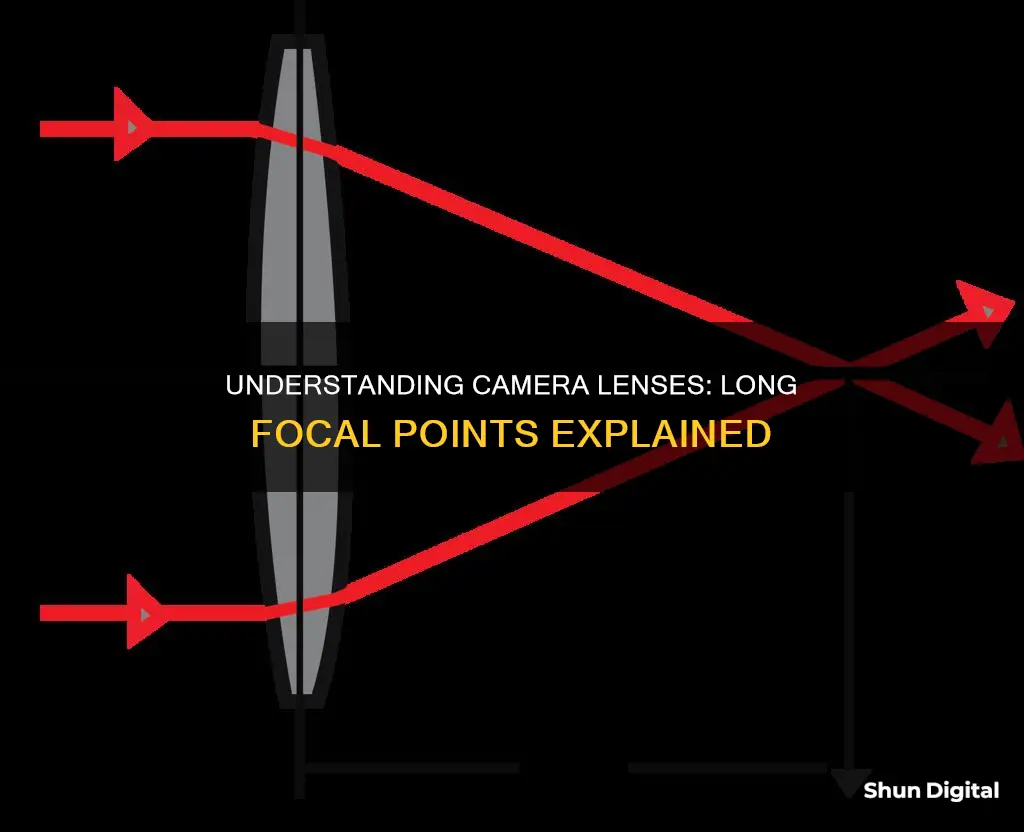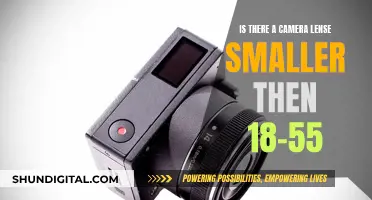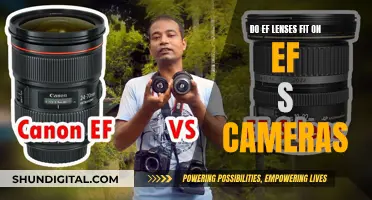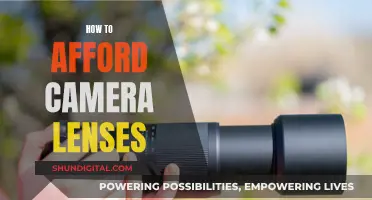
Camera lenses are available in a variety of focal lengths, ranging from extremely short (8mm) to extremely long (600mm and beyond). The focal length of a lens is the distance in millimetres between the optical centre of the lens and the camera sensor, where light information is recorded. In simple terms, it determines the lens's angle of view and how much of the scene will be captured in the photo.
Lenses with shorter focal lengths have a wider angle of view and are used in architectural, documentary, and landscape photography. Lenses with longer focal lengths have a narrower angle of view and are used in sports, wildlife, and wedding photography.
The focal length of a lens is not the same as its physical length. Lenses with the same focal length can have different physical lengths depending on their maximum aperture.
| Characteristics | Values |
|---|---|
| Definition | The distance measured in millimetres, between the optical centre of the lens and the camera sensor, where light information is recorded |
| Focal length of a thin lens in air | The distance from the centre of the lens to the principal foci (or focal points) of the lens |
| Focal length of a thin convex lens | The distance at which a beam of collimated light will be focused to a single spot |
| Focal length of a diverging lens | The distance to the point from which a collimated beam appears to be diverging after passing through the lens |
| Focal length of a concave lens | The point at which the spreading beams of light meet when they are extended backwards |
| Effective focal length (EFL) | The inverse of the optical power of an optical system, and is the value used to calculate the magnification of the system |
| Front focal length (FFL) | The distance from the front focal point F to the front principal plane H |
| Rear focal length (RFL) | The distance from the rear principal plane H' to the rear focal point F' |
| Front focal distance (FFD) | The distance from the front focal point of the system (F) to the vertex of the first optical surface (S1) |
| Back focal distance (BFD) | The distance from the vertex of the last optical surface of the system (S2) to the rear focal point (F') |
| Focal length of a lens | The distance between the image plane and a pinhole that images distant objects the same size as the lens in question |
| Field of view (FOV) | The amount of space seen on the image plane |
| Field of view of a standard rectilinear lens | 2arctan(x/2f) where x is the width of the film or imaging sensor |
What You'll Learn
- Focal length is the distance between the optical centre of the lens and the camera sensor
- The focal length determines the lens's field of view
- Longer focal lengths are associated with lower magnification
- The focal length is the inverse of the system's optical power
- Focal length is important because it relates to the field of view of a lens

Focal length is the distance between the optical centre of the lens and the camera sensor
Focal length is a key concept in photography, and understanding it is crucial to understanding how your camera works. Focal length is the distance between the optical centre of the lens and the camera sensor. This distance is measured in millimetres and is determined with the camera focused on infinity. The focal length of a lens dictates what your camera can focus on and how your images will turn out.
The focal length of a lens determines its field of view. A longer focal length results in a narrower area of the scene captured by the lens, while a shorter focal length captures a much broader view. This is why a telephoto lens has a longer focal length than a wide-angle lens. For example, the Canon RF 1200mm F8L IS USM telephoto lens has a much narrower angle of view than the Canon RF 16mm F2.8 STM lens.
The focal length of a lens also determines whether you capture a wide vista or a close-up of a distant subject. Lenses with shorter focal lengths require photographers to stand closer to their subjects to fill the frame. They are ideal for environmental portraiture, large groups, and small spaces. Lenses with longer focal lengths, on the other hand, allow photographers to keep their distance from the subjects. This makes them suitable for situations where the photographer needs to remain unobtrusive, such as sports, wildlife, or wedding photography.
The focal length of a lens also impacts the angle of view. A shorter focal length produces a wider angle of view, while a longer focal length results in a narrower angle of view. This is why a 24mm lens has a wider angle of view than a 1200mm lens.
It is important to note that the focal length of a lens is not the same as the distance to the subject in focus, which is known as the focus distance. The focus distance is measured from the image plane (sensor/film plane) to the subject. Additionally, the distance from the lens to the subject is called the working distance, which can be significantly less in the context of macro photography.
In summary, the focal length of a lens is a crucial factor in photography as it determines the lens's field of view, angle of view, and the type of scene captured. It also influences the distance between the photographer and the subject, with shorter focal lengths requiring closer proximity and longer focal lengths allowing for more distance.
Anti-Camera Lenses: Worth the Investment?
You may want to see also

The focal length determines the lens's field of view
The focal length of a camera lens is an optical property of the lens. It is the distance, usually measured in millimetres, between the nodal or optical centre of the lens and the camera's sensor. The nodal point is where light converges in a lens.
The focal length also determines the magnification of the image, or how large the subjects in the frame will appear. Longer focal lengths increase the magnification, making distant objects appear closer. This is why longer focal lengths are often used in sports and wildlife photography.
The focal length of a lens is not the same as its physical length, and it is not determined by the overall size of the lens. The focal length is determined by the distance between the optical centre of the lens and the camera sensor when the lens is focused on something very far away, or focused to infinity.
The focal length of a lens is usually displayed on the barrel of the lens, and lenses are named by their focal length. For example, a 50mm lens has a focal length of 50mm.
The focal length of a lens is an innate property of the lens and is not changed by cropping a photo. However, the size of the camera sensor will impact the field of view of the image. Smaller sensors will result in a narrower field of view, as they are essentially cropping the image captured by the lens.
Prime lenses have a single, fixed focal length, while zoom lenses have variable focal lengths.
Camera Lenses: Are Their Filters Universal?
You may want to see also

Longer focal lengths are associated with lower magnification
Focal length is a key concept in photography, and understanding it is crucial to understanding how your camera works. The focal length of a lens determines what your camera can focus on, and how your images will turn out.
The focal length of a lens is the distance between the plane of the sensor and the optical centre or nodal point of the lens. This is usually measured in millimetres. The focal length determines the lens's angle of view, which is the area of the scene that will be captured by the lens.
In contrast, shorter focal lengths offer a wider angle of view and are associated with higher magnification. This is because a shorter focal length bends light more sharply, bringing it to a focus over a shorter distance. Shorter focal lengths are often referred to as "wide-angle lenses" and are commonly used in architectural, documentary, and landscape photography. They are also useful for environmental portraiture, large groups, and small spaces, as they can capture a broader view.
It's worth noting that the lens's focal length also affects the field of view in a photograph, which depends on the interaction between the focal length and the camera sensor. Full-frame camera sensors can capture the full angle of view that the focal length can deliver, but crop sensors may not be able to capture all the data, resulting in a smaller effective field of view.
Lens and Camera Compatibility: Are Lenses Camera-Specific?
You may want to see also

The focal length is the inverse of the system's optical power
The focal length of a camera lens is a measure of how strongly the system converges or diverges light. In other words, it determines how much a lens converges or diverges incoming light rays. The focal length is the distance, usually measured in millimetres, between the optical centre of the lens and the camera sensor, where light information is recorded. When light enters the front of a lens, the internal elements bend and shape it so that it converges into a single point of focus, known as the "optical centre".
In photography, a longer focal length (lower optical power) leads to higher magnification and a narrower field of view. Conversely, a shorter focal length (higher optical power) results in lower magnification and a wider field of view. This is because the focal length determines the lens's field of view: the longer the focal length, the narrower the area of the scene captured by the lens.
For example, a lens with a short focal length, such as 24mm, produces a wide-angle view, capturing a broader vista. On the other hand, a telephoto lens with a long focal length, such as 1200mm, has a narrow angle of view, capturing a close-up of a distant subject.
The focal length of a lens is crucial in photography as it determines what the camera can focus on and how the final image will turn out. It is one of the first considerations for photographers when deciding which lens to use to capture a particular scene or subject.
The Importance of Pristine Camera Lenses for Perfect Pictures
You may want to see also

Focal length is important because it relates to the field of view of a lens
Focal length is important because it determines the field of view of a lens, which in turn dictates what a camera can focus on and how the final image will turn out.
The focal length of a lens is the distance between the optical centre of the lens and the camera sensor, where light information is recorded. This distance is measured in millimetres. When light enters a lens, it is bent and shaped so that it converges into a single point of focus, known as the "optical centre".
The longer the focal length, the narrower the area of the scene captured by the lens. This means that a lens with a short focal length captures a much broader view than a lens with a long focal length. For example, a 16mm lens captures a much wider angle than a 1200mm lens.
Focal length also determines whether a lens will capture a wide vista or a close-up of a distant subject. Lenses with longer focal lengths are often referred to as "telephoto lenses". These lenses are ideal for photographing distant subjects without having to move closer to them, making them useful for sports, wildlife, and wedding photography.
Lenses with shorter focal lengths, on the other hand, have a wide angle of view and are commonly used in architectural, documentary, and landscape photography. They are also suitable for environmental portraiture, large groups, and small spaces. However, photos taken with short focal lengths often experience distortion, particularly around the edges.
Mid-length focal lengths, around 50mm, are generally said to have an angle of view similar to the human eye and are used for almost every genre of photography.
Polarized Camera Lenses: Worth the Investment?
You may want to see also
Frequently asked questions
Focal length is the distance, usually measured in millimetres, between the optical centre of the lens and the camera sensor. It is important to note that this measurement is determined when the camera is focused on something very far away or focused at infinity.
Focal length dictates the field of view, or how much of a scene will be captured. It also determines the magnification of the subject in the frame. A longer focal length will result in a narrower field of view and greater magnification, while a shorter focal length will result in a wider field of view and less magnification.
Prime lenses have a fixed focal length, such as 50mm. Zoom lenses, on the other hand, have variable focal lengths, for example, 24-105mm. Zoom lenses are more convenient as they allow you to capture a variety of shots without changing lenses, but prime lenses often offer better optical quality and larger apertures.







